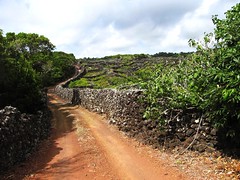On the last post of Portugal Vacations I told you about Sao Jorge Azores, a gorgeous island in the central Azores archipelago. Today I'll tell you a little about Graciosa, another of the Central Azores islands and a pristine Portuguese Gem.
Discovered 1n 1450 by Portuguese explorers, Graciosa was first settled by Vasco Gil Sodré and his family. Vasco left his home in Coimbra (Northern Portugal) searching for a for his riches in the Azores.
Today, most of the 4700 residents on this island are descendants of settlers from northern Portugal and France. This absolutely stunning oval shaped island is the northernmost island of the central group. The island has a total area of approximately 61 km² with a length of 10 km and width of only 7 km making it one of the smaller islands. The majority of the island's population reside in the Santa Cruz municipality.
 Graciosa means (Graceful in English) and it lives up to its name. Like all the other islands, it is a green paradise, with soft rolling hills and tranquil gardens. Graciosa is the flattest of all Azorean islands, but also one of the most intriguing. Hidden in the islands Caldeira is the "Furna do Enxofre" (Sulphur Cavern), a breathtaking cavern rising up to 80 meters high and concealing a magnificent underground lake. Since Graciosa is one large dormant volcano, hot springs and thermal baths are a specialty on the island and a great way to rejuvenate. See image to the left of the thermal spa.
Graciosa means (Graceful in English) and it lives up to its name. Like all the other islands, it is a green paradise, with soft rolling hills and tranquil gardens. Graciosa is the flattest of all Azorean islands, but also one of the most intriguing. Hidden in the islands Caldeira is the "Furna do Enxofre" (Sulphur Cavern), a breathtaking cavern rising up to 80 meters high and concealing a magnificent underground lake. Since Graciosa is one large dormant volcano, hot springs and thermal baths are a specialty on the island and a great way to rejuvenate. See image to the left of the thermal spa.Graciosa is a must see on your Azores Travel and a perfect way to enjoy your Portugal Vacation.









